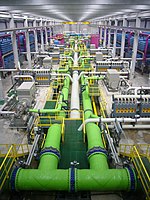
Photo from wikipedia
Abstract Batch RO is a concept for achieving the minimum possible energy consumption in desalination, even at high recoveries. We present a batch RO design that operates cyclically in two… Click to show full abstract
Abstract Batch RO is a concept for achieving the minimum possible energy consumption in desalination, even at high recoveries. We present a batch RO design that operates cyclically in two alternating phases. The system uses a free piston, housed in a pressure vessel, to transfer pressure from the feed fluid to the recirculating fluid. No complete design procedure for this configuration currently exists. To fill this gap, we present a systematic model based on justified assumptions. The specific energy consumption (SEC) is broken down into contributions from the feed pump, recirculating pump, and auxiliary loads. The calculation of feed pump SEC includes three non-ideal correction factors: concentration polarisation, longitudinal concentration gradient, and salt retention. The model requires only the solution of explicit algebraic equations, without need of specialised numerical techniques, and is implemented in a simple 3-step procedure. The model is applied to an example involving desalination of brackish water using an 8-inch spiral-wound RO module. The design parameters are explored and optimised in a sensitivity analysis. The results show that the optimised batch RO at 80% recovery can produce fresh water with low-energy consumption, achieving 2nd law efficiency of 33.2% compared to 10–15% for conventional brackish water RO.
Journal Title: Desalination
Year Published: 2020
Link to full text (if available)
Share on Social Media: Sign Up to like & get
recommendations!